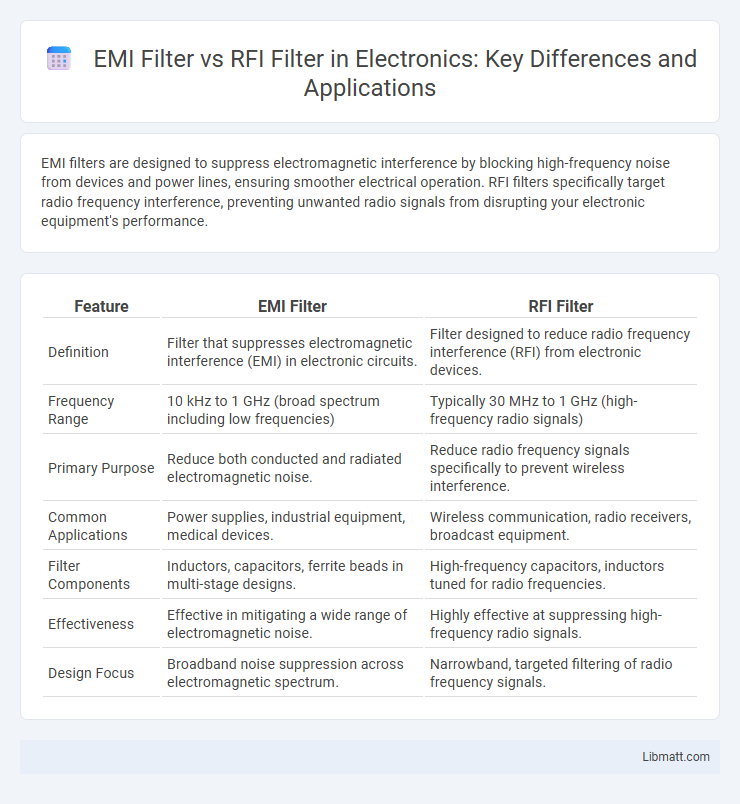EMI filters are designed to suppress electromagnetic interference by blocking high-frequency noise from devices and power lines, ensuring smoother electrical operation. RFI filters specifically target radio frequency interference, preventing unwanted radio signals from disrupting your electronic equipment's performance.
Table of Comparison
| Feature | EMI Filter | RFI Filter |
|---|---|---|
| Definition | Filter that suppresses electromagnetic interference (EMI) in electronic circuits. | Filter designed to reduce radio frequency interference (RFI) from electronic devices. |
| Frequency Range | 10 kHz to 1 GHz (broad spectrum including low frequencies) | Typically 30 MHz to 1 GHz (high-frequency radio signals) |
| Primary Purpose | Reduce both conducted and radiated electromagnetic noise. | Reduce radio frequency signals specifically to prevent wireless interference. |
| Common Applications | Power supplies, industrial equipment, medical devices. | Wireless communication, radio receivers, broadcast equipment. |
| Filter Components | Inductors, capacitors, ferrite beads in multi-stage designs. | High-frequency capacitors, inductors tuned for radio frequencies. |
| Effectiveness | Effective in mitigating a wide range of electromagnetic noise. | Highly effective at suppressing high-frequency radio signals. |
| Design Focus | Broadband noise suppression across electromagnetic spectrum. | Narrowband, targeted filtering of radio frequency signals. |
Introduction to EMI and RFI Filters
EMI filters and RFI filters are essential components designed to suppress unwanted electromagnetic interference and radio frequency interference, respectively, ensuring the smooth operation of electronic devices. EMI filters target a broad range of electromagnetic noise generated by electrical circuits, while RFI filters specifically address high-frequency radio signals that can disrupt communication systems. Understanding the differences helps you select the appropriate filter to protect your equipment from signal distortion and performance issues.
Defining EMI: What is Electromagnetic Interference?
Electromagnetic Interference (EMI) refers to unwanted electrical noise that disrupts the normal operation of electronic devices by emitting electromagnetic waves across various frequencies. EMI filters are designed to suppress a broad range of these disturbances, ensuring your equipment maintains signal integrity and performance. Unlike RFI filters, which focus specifically on high-frequency radio signals, EMI filters provide comprehensive protection against both conducted and radiated interference across multiple frequency bands.
Understanding RFI: What is Radio Frequency Interference?
Radio Frequency Interference (RFI) is electromagnetic disturbance that affects radio signals, originating from various electronic devices operating at radio frequencies typically between 3 kHz and 300 GHz. RFI can degrade the performance of communication systems, causing noise and signal disruption. Unlike EMI filters that target a broader spectrum of electromagnetic interference across multiple frequency ranges, RFI filters specifically attenuate high-frequency noise to protect sensitive radio and communication equipment.
Key Differences Between EMI and RFI Filters
EMI filters primarily target a broad spectrum of electromagnetic interference generated by electrical devices, reducing both conducted and radiated noise, while RFI filters specifically focus on high-frequency radio frequency interference. EMI filters often include multiple stages of attenuation components such as inductors and capacitors designed for lower frequency ranges, whereas RFI filters emphasize suppression at higher frequency bands using specialized ferrite cores and capacitive elements. The key difference lies in their application scope: EMI filters manage overall electromagnetic disturbances, whereas RFI filters are tailored for mitigating radio signal interference commonly affecting communication systems.
How EMI Filters Work
EMI filters work by attenuating electromagnetic interference through components like inductors and capacitors that block or shunt unwanted high-frequency noise away from electronic circuits. These filters target conducted and radiated unwanted signals, ensuring your devices operate smoothly without interference from external electromagnetic sources. Proper application of an EMI filter enhances the reliability and performance of sensitive electronic equipment by maintaining signal integrity.
How RFI Filters Operate
RFI filters operate by specifically targeting high-frequency radio frequency interference through the use of inductors and capacitors that block or attenuate unwanted signals. These filters create a low-impedance path for RFI noise, effectively shunting it away from sensitive circuits and preventing signal degradation. Unlike general EMI filters, RFI filters are optimized to handle frequencies typically in the range of 30 kHz to 1 GHz, ensuring cleaner electromagnetic environments.
Applications of EMI Filters
EMI filters are essential in industrial equipment, medical devices, and consumer electronics to minimize electromagnetic interference and ensure stable performance. Your electronic systems benefit from EMI filters by maintaining compliance with regulatory standards and preventing signal degradation. These filters protect sensitive components from noise generated by motors, switching power supplies, and wireless communication devices.
Applications of RFI Filters
RFI filters are essential in applications where reducing radio frequency interference is critical, such as in telecommunications, medical equipment, and high-frequency electronic devices. These filters prevent unwanted radio signals from causing disruptions, ensuring clearer communication and more reliable operation of sensitive equipment. Using RFI filters improves your system's electromagnetic compatibility and protects against data loss or signal corruption caused by RF noise.
Selection Criteria: Choosing Between EMI and RFI Filters
Selecting between EMI and RFI filters depends on the specific frequency range and type of interference affecting your equipment; EMI filters target a broader electromagnetic spectrum, while RFI filters focus on high-frequency radio signals. Consider the source and characteristics of the noise, along with regulatory standards and the required attenuation levels. Your choice should ensure optimal noise suppression to protect sensitive electronics and maintain compliance with electromagnetic compatibility (EMC) requirements.
Summary: EMI vs RFI Filters in Modern Electronics
EMI filters and RFI filters both serve to suppress unwanted electromagnetic disturbances, but EMI filters target a broader range of frequencies including both conducted and radiated interference, while RFI filters specifically focus on high-frequency radio signals. Modern electronics often rely on EMI filters to ensure compliance with regulatory standards by reducing noise that can affect device performance and communication reliability. Choosing the right filter optimizes your equipment's electromagnetic compatibility and minimizes disruptions caused by electromagnetic interference or radio-frequency interference.
EMI filter vs RFI filter Infographic

 libmatt.com
libmatt.com